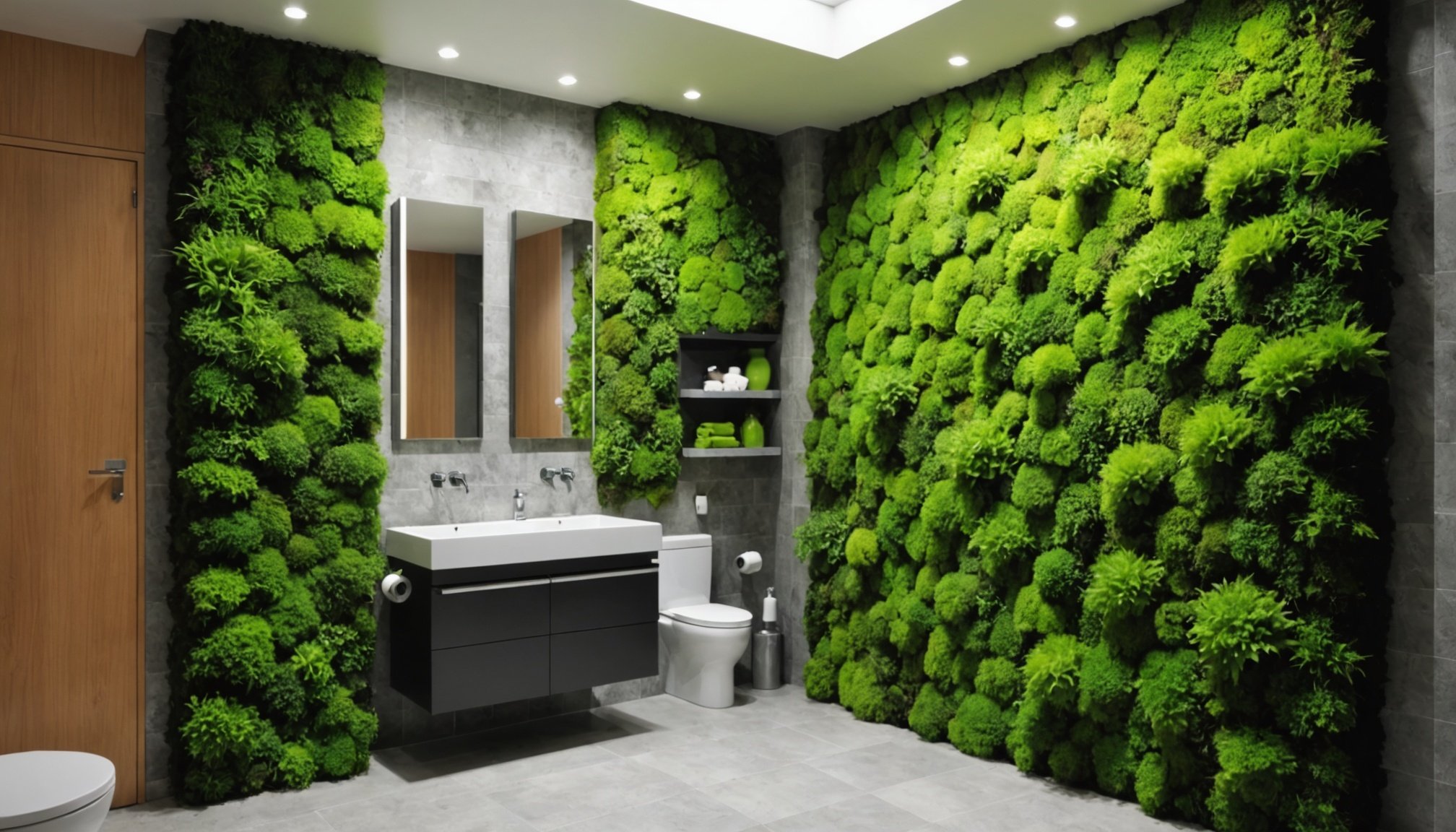Benefits of Vertical Moss Walls
Transform your space with vertical moss walls to improve both aesthetics and functionality. These living installations provide several benefits, starting with enhanced air quality. Moss naturally filters the air, trapping particles and releasing oxygen, contributing to a healthier home environment. This can be particularly beneficial in bathrooms, where a clean atmosphere is crucial.
Another significant advantage of vertical moss walls is moisture regulation. They excel at maintaining stable humidity levels, absorbing excess moisture when necessary. This feature not only reduces the risk of mold and mildew but can also make bathrooms more comfortable by preventing dampness and musty odours from developing.
Additional reading : Transform your kitchen into a zero-waste oasis: explore the top sustainable design layouts for eco-friendly living
In addition to their practical benefits, vertical moss walls enhance bathroom aesthetics. Their unique design adds a touch of nature, creating a tranquil and refreshing atmosphere. Imagine stepping into a bathroom where the lush texture and vibrant green colour of moss offers a one-of-a-kind visual appeal.
Choosing vertical moss walls is an easy way to modernize your space and elevate your home’s overall design. With natural filtration, moisture control, and a captivating appearance, they offer a combination of benefits that makes them an excellent choice for any bathroom.
Have you seen this : Creating the ultimate indoor-outdoor kitchen blend for unforgettable entertaining experiences
Materials Needed for Installation
When embarking on creating a stunning moss wall, it’s vital to gather a moss wall kit, ensuring you have everything necessary for a smooth installation. Understanding the types of moss suitable for vertical installations is crucial. Common choices include preserved reindeer moss, flat moss, and mood moss, each offering unique textures and colours to enhance your design.
In addition to the moss itself, you’ll need essential installation materials. These often include an adhesive backing or panel system to secure the moss to your chosen surface. Depending on your kit, additional supplies might contain gloves, a cutting tool, and possibly a framework for larger installations.
A range of tools for moss walls is essential to achieve precision and quality. Basic tools include scissors or a utility knife for trimming the moss, a tape measure for accurate sizing, and a level to ensure proper alignment on the wall.
For successful mounting, it’s important to select the right wall substrates and mounting options. Smooth surfaces like concrete, drywall, or painted walls are ideal. If you’re looking to mount on wood or fabric, ensure these materials are prepared to support the extra weight. Proper preparation will ensure a lasting and visually appealing moss wall.
Step-by-Step Installation Process
Setting up a vertical garden in your bathroom can be both rewarding and aesthetically pleasing. In this guide, we’ll walk you through the necessary steps for a successful moss wall installation.
Preparing the Bathroom Space
The first step involves evaluating and preparing the wall surface to ensure it’s adept for installing moss walls. It’s crucial to choose a wall away from direct water splash yet within reach of moisture. Clean the wall thoroughly; a professional moss wall installation guide often recommends an anti-fungal wash to prevent growth issues. Consider the weight of the installation to ensure the wall can support it.
Arranging and Securing the Moss
Once the wall’s ready, arrange the moss to achieve optimal coverage and visual appeal. Use a combination of different moss types to create depth and texture. Secure each piece with eco-friendly adhesive suitable for moist environments. Proper placement is key in a vertical garden setup to ensure uniform growth and colour distribution.
Final Touches and Sealing
After arranging the moss, it’s vital to seal and protect the installation from potential water damage. Consider using a clear, water-resistant sealant. This will help maintain the moss’s vibrant hues while keeping your bathroom space elegant and sustainable. Regular maintenance checks ensure longevity and continued visual satisfaction.
Maintenance Tips for Moss Walls
Ensuring proper moss wall care involves understanding its unique requirements. These walls, though relatively low-maintenance, do demand attention, particularly concerning humidity management.
For optimal results, regularly check humidity levels as moss thrives in a moderately humid environment. Generally, maintaining humidity levels between 40% and 60% is ideal. If the humidity in the room falls below this, consider using a humidifier to create a suitable atmosphere.
Watering frequency is another key aspect of maintaining moss walls. Unlike potted plants, moss walls require minimal direct watering. Instead, they draw moisture from the air, so only water lightly if the environment becomes too dry. Over-watering can promote mold growth, so tread carefully.
Cleaning is crucial to avoid mold and discoloration. Gently dust the surfaces with a soft cloth every few months to prevent dirt accumulation. Ensure that all cleaning tools are dry to safeguard the moss wall care process.
Address common issues promptly. If the moss dries out or shows discoloration, identify the root cause. Often, this stems from inadequate humidity or overexposure to sunlight. Adjust environmental factors to restore its natural vibrancy. Remember, understanding your moss wall’s needs is key to its longevity.
Design Ideas for Moss Walls in Bathrooms
Explore the world of bathroom design inspiration by incorporating moss wall decor for a refreshing twist. Transforming your bathroom into a green haven can be accomplished by creatively integrating moss walls with other natural elements.
Start by pairing moss with elements such as wood or stone. This combination not only enhances the aesthetic appeal but also introduces an organic, warm ambiance. Consider the creative moss applications in areas like shower enclosures or accent walls to provide a seamless flow with natural materials.
Colour and texture play significant roles in ensuring a vibrant look. Mix various shades of green moss with pots of different textures. This creates depth and a dynamic visual appeal. Pair bright moss with dark stones or tiles for contrast, or blend different moss types for a rich tactile experience.
For those who love to update their space with the seasons, seasonal or thematic decor ideas are a fantastic option. In winter, add snowflake decals or frost-touched accents. Alternatively, use seashells and starfish during summer months. These themes added to a backdrop of lush moss resonate with the season and enhance personal design preferences in your bathroom sanctuary.
FAQs Regarding Moss Care and Humidity
Many moss enthusiasts have common concerns, particularly regarding how humidity affects their green plants. Understanding these factors can ensure optimal moss care and prevent issues like mold.
Mold and mildew often prompt questions among moss caregivers. The truth? While moss thrives in humid environments, excessive humidity can result in mold growth. It is crucial to maintain balance to support healthy moss without encouraging unwanted pathogens. Moss FAQs often highlight the importance of airflow to prevent such mildew concerns.
What humidity level is best for moss? Moss generally flourishes in humidity levels between 50% and 90%. Within this range, moss remains vibrant and lush. However, every type of moss might have different preferences, and slight adjustments may be necessary based on specific species.
Adapting moss care for varying bathroom conditions can be straightforward. For dry conditions, occasional misting helps sustain moisture levels. Conversely, in excessively damp bathrooms, ensuring proper ventilation prevents oversaturation, averting mold issues. Placing moss in indirect light can also support its growth while moderating humidity.
In summary, understanding and addressing these moss FAQs helps enthusiasts maintain their moss gardens. Adapting care practices to meet humidity requirements and environmental elements ensures a balanced, healthy environment for moss.











